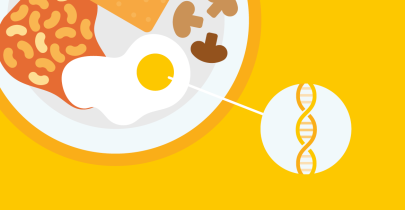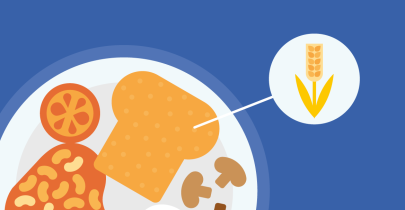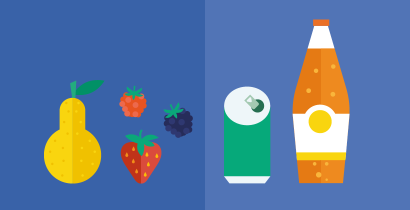The Functions of Carbohydrates in the Body
Last Updated : 14 January 2020In this part of our review on carbohydrates, we explain the different types and basic functions of carbohydrates including sugars. For an overview of how the consumption of carbohydrates is linked to health, please refer to the article on ‘Are carbohydrates good or bad for you?’.
1. Introduction
Alongside fat and protein, carbohydrates are one of the three macronutrients in our diet with their main function being to provide energy to the body. They occur in many different forms, like sugars and dietary fibre, and in many different foods, such as whole grains, fruit and vegetables. In this article, we explore the variety of carbohydrates that occur in our diet and their functions.
2. What are carbohydrates?
At their most basic, carbohydrates are made of building blocks of sugars, and can be classified according to how many sugar units are combined in their molecule. Glucose, fructose and galactose are examples of single-unit sugars, also known as monosaccharides. Double-unit sugars are called disaccharides, among which sucrose (table sugar) and lactose (milk sugar) are most widely known. Monosaccharides and disaccharides are usually referred to as simple carbohydrates. Long-chain molecules, such as starches and dietary fibres, are known as complex carbohydrates. In reality, though, there are more distinct differences. Table 1 gives an overview of the major types of carbohydrates in our diet.
Table 1. Examples of carbohydrates based on the different classifications.
CLASS |
EXAMPLES |
Monosaccharides |
Glucose, fructose, galactose |
Disaccharides |
Sucrose, lactose, maltose |
Oligosaccharides |
Fructo-oligosaccharides, malto-oligosaccharides |
Polyols |
Isomalt, maltitol, sorbitol, xylitol, erythritol |
Starch polysaccharides |
Amylose, amylopectin, maltodextrins |
Non-starch polysaccharides |
Cellulose, pectins, hemicelluloses, gums, inulin |
Carbohydrates are also known under the following names, which usually refer to specific groups of carbohydrates1:
- sugars
- simple and complex carbohydrates
- resistant starch
- dietary fibres
- prebiotics
- intrinsic and added sugars
The different names come from the fact that carbohydrates are classified depending on their chemical structure, but also based on their role, or source in our diet. Even leading public health authorities have no aligned common definitions for different groups of carbohydrates2.
3. Types of carbohydrates
3.1. Monosaccharides, disaccharides and polyols
Simple carbohydrates – those with one or two sugar units – are also simply known as sugars. Examples are:
- Glucose and fructose: monosaccharides that can be found in fruits, vegetables, honey, but also in food products like glucose-fructose syrups
- Table sugar or sucrose is a disaccharide of glucose and fructose, and occurs naturally in sugar beet, sugar cane and fruits
- Lactose, a disaccharide consisting of glucose and galactose, is the main carbohydrate in milk and dairy products
- Maltose is a glucose disaccharide found in malt and starch derived syrups
Monosaccharide and disaccharide sugars tend to be added to foods by manufacturers, cooks and consumers and are referred to as ‘added sugars’. They may also occur as ‘free sugars’ that are naturally in honey and fruit juices.
Polyols, or so-called sugar alcohols, are also sweet and can be used in foods in a similar way to sugars, but have a lower calorie content compared to normal table sugar (see below). They do occur naturally, but most polyols that we use are made by the transformation of sugars. Sorbitol is the most commonly used polyol in foods and drinks, while xylitol is frequently used in chewing gums and mints. Isomalt is a polyol produced from sucrose, often used in confectionery. Polyols can have a laxative effect when eaten in too large quantities.
If you want to find out more about sugars in general, read our ‘Sugars: addressing common questions’ article, the ‘Addressing common questions about sweeteners’ article, or investigate the opportunities and difficulties in replacing sugar in baked goods and processed foods (‘Sugars from a food technology perspective’).
3.2. Oligosaccharides
The World Health Organization (WHO) defines oligosaccharides as carbohydrates with 3-9 sugar units, although other definitions allow for slightly longer chain lengths. The most well-known are oligofructans (or in proper scientific terms: fructo-oligosaccharides), which consist of up to 9 fructose units and naturally occur in low sweetness vegetables such as artichokes and onions. Raffinose and stachyose are two other examples of oligosaccharides found in some pulses, grains, vegetables, and honey. Most of the oligosaccharides are not broken down into monosaccharides by human digestive enzymes and are utilised by the gut microbiota instead (see our material on dietary fibres for more information).
3.3. Polysaccharides
Ten or more – and sometimes even up to several thousand – sugar units are needed to form polysaccharides, which are usually distinguished in two types:
- Starch, which is the main energy reserve in root vegetables such as onions, carrots, potatoes, and whole grains. It has different length chains of glucose, more or less branched, and occurs in granules which size and shape vary between the plants that contain them. The corresponding polysaccharide in animals is called glycogen. Some starches can only be digested by the gut microbiota rather than our own body’s mechanisms: these are known as resistant starches.
- Non-starch polysaccharides, which are part of the dietary fibre group (although a few oligosaccharides such as inulin are also considered dietary fibre). Examples are cellulose, hemicelluloses, pectins and gums. The main sources of these polysaccharides are vegetables and fruits, as well as whole grains. A hallmark feature of non-starch polysaccharides and actually all dietary fibres is that humans cannot digest them; hence, their lower average energy content compared to most other carbohydrates. Some types of fibre can, however, be metabolised by gut bacteria, giving rise to compounds beneficial for our body, such as short-chain fatty acids. Find out more about dietary fibres and their importance for our health in our article on ‘whole grains’ and ‘dietary fibre’.
From here onwards, we will be referring to ‘sugars’ when talking about mono- and disaccharides, and ‘fibres’ when talking about non-starch polysaccharides.
4. Functions of carbohydrates in our body
Carbohydrates are an essential part of our diet. Most importantly, they provide the energy for the most obvious functions of our body, such as moving or thinking, but also for the ‘background’ functions that most of the time we do not even notice1. During digestion, carbohydrates that consist of more than one sugar get broken down into their monosaccharides by digestive enzymes, and then get directly absorbed causing a glycaemic response (see below). The body uses glucose directly as energy source in muscle, brain and other cells. Some of the carbohydrates cannot be broken down and they get either fermented by our gut bacteria or they transit through the gut without being changed. Interestingly, carbohydrates also play an important role in the structure and function of our cells, tissues and organs.
4.1. Carbohydrates as energy source and their storage
Carbohydrates broken down to mainly glucose are the preferred source of energy for our body, as cells in our brain, muscle and all other tissues directly use monosaccharides for their energy needs. Depending on the type, a gram of carbohydrates provides different amounts of energy:
- Starches and sugars are the main energy-providing carbohydrates, and supply 4 kilocalories (17 kilojoules) per gram
- Polyols provide 2.4 kilocalories (10 kilojoules) (erythritol is not digested at all, and thus gives 0 calories)
- Dietary fibre 2 kilocalories (8 kilojoules)
Monosaccharides are directly absorbed by the small intestine into the bloodstream, where they are transported to the cells in need. Several hormones, including insulin and glucagon, are also part of the digestive system. They maintain our blood sugar levels by removing or adding glucose to the blood stream as needed.
If not used directly, the body converts glucose to glycogen, a polysaccharide like starch, which is stored in the liver and the muscles as a readily available source of energy. When needed, for instance, between meals, at night, during spurs of physical activity, or during short fasting periods, our body converts glycogen back to glucose to maintain a constant blood sugar level.
The brain and the red blood cells are especially dependent on glucose as energy source, and can use other forms of energy from fats in extreme circumstances, like in very extended periods of starvation. It is for this reason that our blood glucose must be constantly maintained at an optimum level. Approximately 130 g of glucose are needed per day to cover the energy needs of the adult brain alone.
4.2. The glycaemic response and glycaemic index
When we eat a carbohydrate-containing food, blood glucose level rises and then decreases, a process known known as the glycaemic response. It reflects the rate of digestion and absorption of glucose, as well as the effects of insulin in normalising the blood glucose level. A number of factors influence the rate and duration of the glycaemic response:
- The food itself:
- The type of the sugar(s) that form(s) the carbohydrate; e.g. fructose has a lower glycaemic response than glucose, and sucrose has a lower glycaemic response than maltose
- The structure of the molecule; e.g. a starch with more branches is more easily broken down by enzymes and therefore more readily digestible than others
- The cooking and processing methods used
- The amount of other nutrients in the food, such as fat, protein, and fibre
- The (metabolic) circumstances in every individual:
- The extent of chewing (mechanical breakdown)
- The rate of gastric emptying
- Transit time through the small intestine (which is partly influenced by the food)
- Metabolism itself
- The time of day the food is ingested
The impact of different foods (as well as the processing technique of foods) on the glycaemic response is classified relative to a standard, usually white bread or glucose, within two hours after eating. This measurement is called the glycaemic index (GI). A GI of 70 means that the food or drink causes 70% of the blood glucose response which would be observed with the same amount of carbohydrate from pure glucose or white bread; however, most of the time carbohydrates are eaten as a mixture and alongside proteins and fats which all influence the GI.
High GI foods cause a greater blood glucose response than low GI foods. At the same time, foods with a low GI are digested and absorbed more slowly than foods which have a high GI. There is a lot of discussion in the scientific community, but currently insufficient evidence to suggest that a diet based on low GI foods is associated with a reduced risk of developing metabolic diseases such as obesity and type 2 diabetes.
THE GLYCAEMIC INDEX OF SOME COMMON FOODS (using glucose as standard) |
|
Foods with a very low GI (≤ 40) |
Raw apple |
Foods with a low GI (41-55) |
Noodles and pasta |
Foods with an intermediate GI (56-70) |
Brown rice |
Foods with a high GI (> 70) |
White and wholemeal bread |
4.3. Gut function and dietary fibre
Although our small intestine is unable to digest dietary fibre, fibre helps to ensure good gut function by increasing the physical bulk in the bowel, and thereby stimulating the intestinal transit. Once the indigestible carbohydrates pass into the large intestine, some types of fibre such as gums, pectins and oligosaccharides are broken down by the gut microflora. This increases the overall mass in the bowel and has a beneficial effect on the make-up of our gut microflora. It also leads to formation of bacterial waste products, like the short-chain fatty acids, which are released in the colon with beneficial effects on our health (see our dietary fibre articles for more information).
5. Summary
Carbohydrates are one of the three macronutrients in our diet, and as such essential for the proper functioning of the body. They come in different forms, ranging from sugars over starch to dietary fibre, and are present in many foods we eat. If you want to find out more about how they affect our health, read our article on ‘Are carbohydrates good or bad for you?’.



